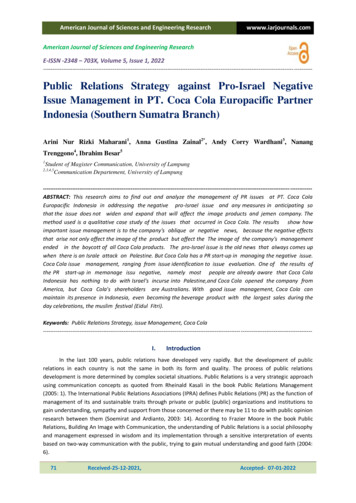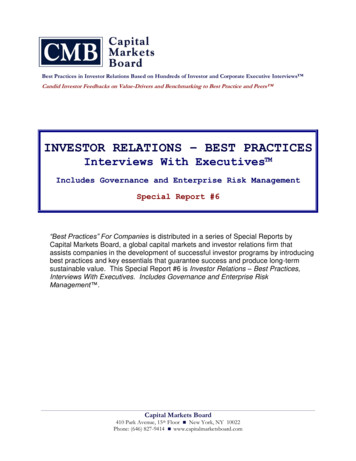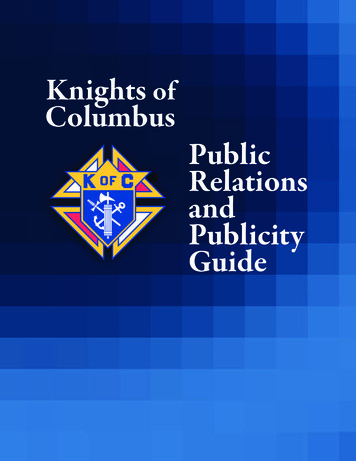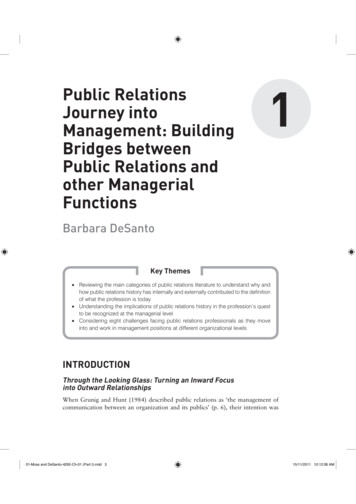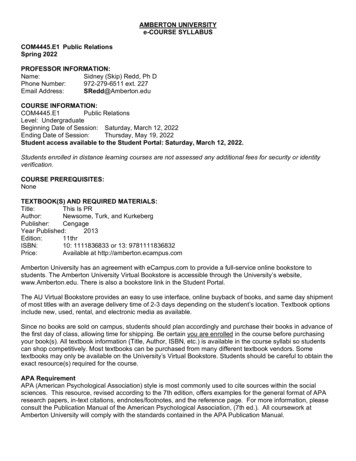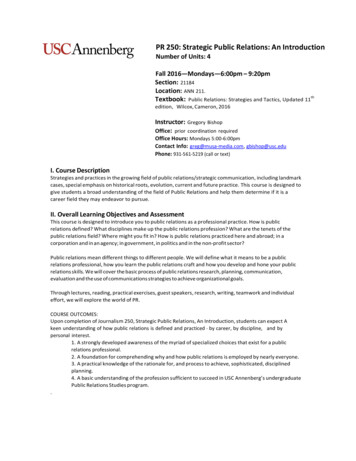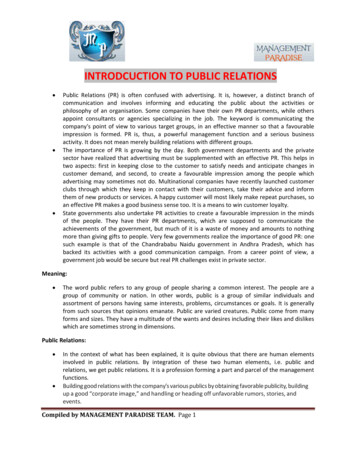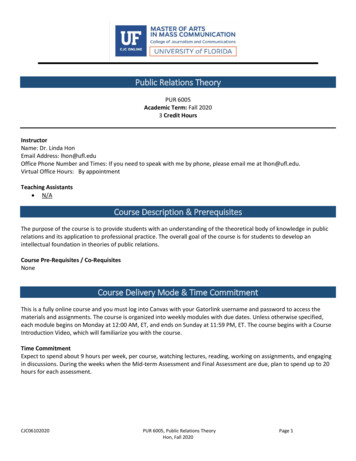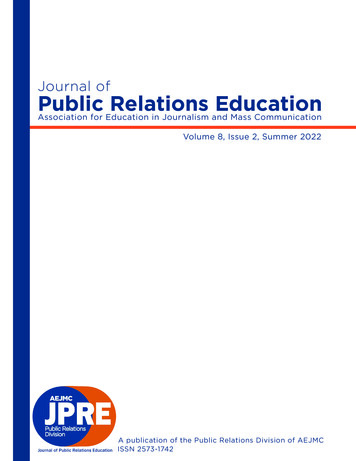
Transcription
Journal ofPublic Relations EducationAssociation for Education in Journalism and Mass CommunicationVolume 8, Issue 2, Summer 2022A publication of the Public Relations Division of AEJMCISSN 2573-1742
Volume 8, Issue 2, Summer 2022A publication of the Public Relations Division of AEJMCISSN 2573-1742 Copyright 2022 AEJMC Public Relations Division
Journal of Public Relations EducationEditorial StaffPamela Bourland-Davis, Georgia Southern University, Editor in Chief,Melissa Janoske McLean, Tenured and Beyond Coaching, LLC, Senior Associate EditorLaShonda Eaddy, Pennsylvania State University, Associate EditorStephanie Mahin, Kenan-Flagler, UNC, Associate Editor of Book and Resource ReviewsChristopher McCollough, Jacksonville State University, Associate EditorLuke Capizzo, James Madison University, Associate EditorBrandi Watkins, Virginia Tech, Associate EditorAdrienne Wallace, Grand Valley State University, Assistant EditorKatharine Ours, Georgia Southern University, Administrative Assistant
Journal of Public Relations EducationEditorial Review BoardGiselle A. Auger, Rhode Island CollegeNilanjana Bardham, Southern Illinois University, CarbondaleDenise Bortree, Penn State UniversityLois A. Boynton, University of North Carolina - Chapel HillKenon A. Brown, University of AlabamaBrigitta R. Brunner, Auburn UniversityDebbie Davis,* Texas Tech UniversityJasper Fessmann, West Virginia UniversityKaren Freberg, University of LouisvilleAmber L. Hutchins, Kennesaw State UniversityCarolyn Mae Kim,* Biola UniversityDean Kruckeberg, University of North Carolina - CharlotteBrooke McKeever, University of South CarolinaJuan Meng, University of GeorgiaJulie O’Neil,* Texas Christian UniversityKatie R. Place, Quinnipiac UniversityDonnalyn Pompper, University of OregonGeah Pressgrove, West Virginia UniversityMatt Ragas, DePaul UniversityDavid Remund,* PRSA FellowKaren Miller Russell, University of GeorgiaKevin Stoker, University of Nevada - Las VegasRebecca Swenson, University of MinnesotaNatalie Tindall, Lamar UniversityElizabeth L. Toth,* University of MarylandTia C.M. Tyree, Howard UniversityDamion Waymer, University of AlabamaDennis L. Wilcox, San Jose State University (Emeritus)Christopher Wilson, Brigham Young University* Reviewers representing the Commission on Public Relations Education
Special Issue Guest Editor LetterIn 2020, the brutal murders of George Floyd, Breonna Taylor, and AhmaudArbery, and the weeks of protest for racial justice that surrounded eachevent, led a group of public relations scholars and educators in activistpublic relations to meet on Zoom to discuss how to integrate topics aboutactivism into our classrooms. Many of us felt a deep divide between ouractivist research interests, our personal commitment to activist causes, andthe types of skills-based, corporate-centric content we teach in our publicrelations courses. While the body of academic literature on the topic ofactivist public relations grows, we noticed a lack of tangible resources andpedagogical research on how to incorporate activism into public relationseducation. As our grassroots group compiled resources, we came up withthe idea for this special issue of the Journal of Public Relations Educationto help bridge the gap, and help other scholars and educators feel lessfragmented between their research and teaching interests. We hopeyou find the articles in this issue useful as a way to incorporate activisttopics into core public relations courses such as research, writing, andcampaigns, or maybe you will be inspired to create a special topics course.The issue opens with an article “Centering Activism and Social Justicein Public Relations Education: Critical Communication Pedagogy asan Entryway” by Aghazadeh and Ashby-King that presents criticalcommunication pedagogy (CCP) as a framework to meaningfully includeactivism in PR curricula and the very dynamics of classroom instruction.In addition to their compelling argument for the importance of integratingsocial justice and activism into the PR classroom, they offer three concretestrategies on how to do this rooted in CCP’s guiding concepts of identity,power, and social (re)production. These include considering the influenceof positionality on communication, student and educator power dynamics,and critiquing discourses and challenging social (re)production.
While the revolution may not be televised, the article, “Called, Committedand Inspiring Activism: How Black PR Guest Speakers Experienced thePR classroom during the COVID-19 and Racial Reckoning AcademicYear of 2020/2021” by Del Rosso and Brown suggests a revolution in theclassroom. One way to do this is by embracing activist pedagogy, whichis about transforming the classroom into a space that decenters privilegeand decolonizes curriculum. The authors interviewed Black publicrelations professionals about their experiences as invited guests and whatprofessors can do to improve them. Four fascinating themes emerged thatspeak directly to why Black PR experts go into the classroom. The authorsprovide a useful guide with actionable suggestions for professors to helpprepare guest speakers for the classroom experience.Teaching activism does not have to be emotionally draining or focusedonly on confrontational tactics. Hou and Wang’s article, “Creativity isthe Key: Incorporating Creative Activism to Public Relations Classroomsthrough Using Creative Pedagogy,” offers creativity as an entry point forthe content, design, and delivery of activist public relations education.Seeing the potential for activism as both joyful and fun, rather thanonly discouraging and negative, may encourage more students toconsider how their public relations skills can be used as part of socialchange movements. For instructors, creative pedagogy also offers waysto revitalize traditional teaching of activist public relations throughplayfulness, hope, and possibilities. Hou and Wang offer a variety of casestudies and participatory activities for integrating creative activism intoPR classes.The fourth article, “Public Interest Communications in the Classroom:Bringing Activism to Public Relations Education” by Chernin andBrunner introduces readers to a newer area of study, Public InterestCommunication or PIC. The authors challenge public relations educators
to use the PIC framework to disrupt the ways in which communicationis taught by moving beyond teaching corporate-focused skills to acurriculum that uses skill-based approaches to mold future activists. Forexample, the PIC framework offers six tactics that, when used as partof strategic communication, can help drive social change. Additionally,Chernin and Brunner offer specific and timely suggestions for how toincorporate PIC into existing public relations programs.The two teaching briefs in this issue offer activism-focused assignmentsthat can be easily adopted into the public relations classroom. In her article“Vaccinate Against Hate: Using Activism to Teach Applied PR Researchand Theory,” Rozelle provides an in-class activity where students aretasked to develop a recruitment campaign and educational and awarenesscampaign for the fictional organization Vaccinate Against Hate. Becausethis activity can be integrated into an introductory public relations course,it offers an easy entry point for students to begin considering the role ofpublic relations in activist causes.More than ever corporations are expected to take a public stance onsocial and political issues. Remaining silent can be a sign of indifference.For example, after the murder of George Floyd, corporations offeredstatements in support of the Black Lives Matter Movement and/or a callto address structural racism. A major criticism of these statements was alack of action and follow through. In “Beyond Slacktivism: Lessons forAuthentic Activist Messages through Public Relations,” Janoske Mcleanand Marks Malone offer timely and practical lessons to teach studentshow to write effective activist statements. Through these lessons, studentsare encouraged to find the organization’s authentic voice as they identifyand practice writing activist statements. Further, this brief offers a lessonon how to respond to positive and negative reactions to corporate activiststatements from the public.
From navigating through a global pandemic, to parenting a toddler, andhaving a difficult pregnancy and unexpected early childbirth, our firsttime editing a journal had its fair share of challenges. A huge thank youto editor Pamela Bourland-Davis (and her editorial team) who workedpatiently with us from idea conception to final production of this issue. Weare immensely grateful for her kindness and understanding throughout theprocess. We would also like to thank the reviewers who quickly acceptedinvitations to review and offered valuable feedback for authors. Throughboth personal and global challenges, we are extraordinarily proud of thisJPRE special issue and hope it jumpstarts conversations about how publicrelations can and should play a transformative role in society and our roleas educators in the process.Stephanie Madden, Ph.D.Assistant ProfessorDonald P. Bellisario College of Communications Penn StateSenior Research Fellow, Arthur W. Page CenterStephanie Mahin, Ph.D.Clinical Assistant ProfessorManagement & Corporate CommunicationUNC Kenan-Flagler Business School
Journal ofPublic Relations EducationAssociation for Education in Journalism and Mass CommunicationVolume 8, Issue 1, Summer 2022Table of ContentsResearch Papers11-41Centering Activism and Social Justice in Public RelationsEducation: Critical Communication Pedagogy as an EntrywaySarah A. Aghazadeh and Drew T. Ashby-King42-77Called, Committed and Inspiring Activism: How Black PR GuestSpeakers Experienced the PR Classroom During the COVID-19and Racial Reckoning Academic Year of 2020/2021David Brown and Teri Del Rosso78-110 Creativity is Key: Using Creative Pedagogy to IncorporateCreative Activism in the Public Relations ClassroomJenny Zhengye Hou and Yi Wang111-146 Public Interest Communications in the Classroom: BringingActivism to Public Relations EducationKelly Chernin and Brigitta BrunnerTeaching Briefs147-157 Vaccinate Against Hate: Using Activism to Teach Applied PRResearch and TheoryArien Rozelle
158-171 Beyond Slacktivism: Lessons for Authentic Activist Messagesthrough Public RelationsMelissa Janoske McLean and Kim MarksBook Reviews172-177 What Does Injustice Have to Do with Me? Engaging PrivilegedWhite Students with Social JusticeReviewed by Karen Lindsey
Journal of Public Relations Education2022, Vol. 8, No. 2, 11-41Centering Activism and Social Justice in PREducation: Critical Communication Pedagogy asan EntrywaySarah A. Aghazadeh, Auburn UniversityDrew T. Ashby-King, University of MarylandABSTRACTPublic relations (PR) research has centered activism to someextent, though a clear, collective commitment to center activismin the U.S. PR classroom is still lacking. Thus, educators havean opportunity to situate activism and social justice as an integralpart of U.S. PR education and effect social change through theirteaching. This essay outlines key considerations of activismresearch and the opportunities to concretize activism in U.S. PReducation, presents critical communication pedagogy (CCP) as aframework to meaningfully include activism in PR curricula, andhighlights why educators should consider teaching social justiceactivism topics. Ultimately, we argue that CCP—and its keyconcepts of identity, power, and social (re)production —providesa theoretical opportunity to purposefully and unapologeticallyintegrate activism into the PR classroom while simultaneouslyadvancing the field to realize its potential for social justice.Keywords: critical communication pedagogy, social justice,activism, public relations educationEditorial Record: Submitted June 15, 2021. Revised November 19, 2021. AcceptedMarch 15, 2022.
12 Aghazadeh& Ashby-KingPublic relations (PR) scholarship has meaningfully integratedactivism into the body of knowledge through a strong line of critical/cultural research (Ciszek, 2015; Weaver, 2019) that transcends activists asorganizational opposition. However, PR education in the United States hasnot followed suit. Many U.S. PR programs do not require or offer activismclasses and often focus on technical skills at the expense of exercisingthese skills for a variety of social justice causes. For instance, Holtzhausen(2011) asserted “the emphasis on writing skills and journalism trainingis arguably the most dominant concept in the training of undergraduatepublic relations practitioners in the United States” (p. 112). Somervilleet al. (2011), from a U.K. perspective, explained the need to balancethe dominant vocational approach to PR education with opportunitiesto explore social issues through critical approaches so students canappropriately apply those vocational skills to global challenges. Withthe research developments for activism in mind, we outline a path tomeaningfully and systematically center activism in PR pedagogy practicesthrough a critical communication approach and argue that PR educationhas the potential to effect meaningful change for social justice.In this essay, we first outline key considerations of activismresearch and the opportunities to meaningfully integrate activism in U.S.PR education. We present critical communication pedagogy (CCP) as aframework to include activism effectively and consistently in PR curriculaand address social justice (Waymer, 2021). We conclude by arguing thatPR education has consequences for social justice and provide supportfor integrating activism into all PR classrooms. Ultimately, CCP—andits key concepts of identity, social (re)production, and power—providesa theoretical opportunity to purposefully include activism into the PRclassroom while simultaneously encouraging educators to consider theconsequences of their teaching practices for students and society.
Vol. 8(2), 2022Journal of Public Relations Education13Activism in Public Relations Research and EducationIn this section, we first present a socio-cultural definition of PRand specific social justice perspective of activism that complement eachother and that we take on as educators. We also detail past and currentresearch about activism with the understanding that teaching activism inthe classroom should be informed by this body of knowledge. Lastly, wepresent pedagogical work at the intersections of culture and social justiceto acknowledge this related and important work, although examplesof teaching activism specifically are scant in PR pedagogy literature.Ultimately, we seek to equip educators with a view of the strengths andlimitations of our understandings of activism to inform their teachingand set the foundation for using CCP to integrate activism into the PRclassroom.PR as Socio-cultural: Opportunities for Social Justice in TeachingMany definitions of PR exist, but broad, non-functionalistunderstandings of PR allow for a more accessible incorporation ofactivism into the discipline (Edwards, 2012; Weaver, 2019) and intothe classroom. Thus, we take on a socio-cultural definition of PR whenconsidering activism. Edwards and Hodges (2011) described the sociocultural orientation as one that recognizes PR as “a locus of transactionsthat produce emergent social and cultural meanings” (p. 4). This sociocultural perspective of PR does not discount or erase the value offunctional approaches to PR, but instead acknowledges the larger, sociocultural context in which organizations exist (Edwards & Hodges, 2011).A socio-cultural perspective also acknowledges how power and resistanceinfluence cultural meaning in ways that can center social justice as aspecific type of social change that some activism seeks to inspire and thatinstructors can embody in their acts of resistance in the classroom.Activism has provided PR education and research with animportant connection to societal discourse, social justice, and social
14 Aghazadeh& Ashby-Kingchange, bringing up questions of power, culture, and resistance. Forinstance, Zoller (2005) explained health activism as “a challenge to theexisting order and power relationships” because it seeks to dispute statusquos, existing dominance for groups and norms, etc. (p. 344). However,the nuances of activism are still up for debate and the examples of whatcounts as activism are sometimes unclear, particularly when “activist”efforts do not advance social justice per se (e.g., guns rights activists, antiabortion activists, etc.).We adopt a specific understanding of activism from a socialjustice perspective—as sustained resistance to and disruption of harmfulinequities, norms, and practices that discriminate against and marginalizepeople to ultimately promote equity (Place & Ciszek, 2021; Weaver,2019). Consequently, we draw from Demetrious (2013) and conceptualizesocial movements as “purposeful collective action which advocates withsocio-political intent” (p. 34). Throughout this essay, we specifically referto a type of social justice activism that seeks to intervene in and addressinequity, oppression, and discrimination within society.Conceptualizations of Activism to Inform TeachingHow we conceptualize activism will necessarily influence howwe teach it, so we present a summary of the body of knowledge aboutactivism. The state of activism research in PR represents a burgeoningarea of study that has evolved from understanding activism from apredominantly managerial perspective to discussing the social and culturalelements of activism for society (Dhanesh & Sriramesh, 2020; Weaver,2019). Although scholars have highlighted how activists have used PRfor over a century (Ciszek, 2015), early PR literature focused on activistsas pressure groups that posed challenges for organizations to manage toachieve organizational goals (Grunig, 1992). PR pedagogy often alignswith the latter perspective, while activism research has continued toexplore socio-cultural realities.
Vol. 8(2), 2022Journal of Public Relations Education15For roughly two decades, scholars have explored how a varietyof advocates and activists employ PR practices and how communicationprofessionals influence social issues (Ciszek, 2015; Ciszek, 2017a;Greenberg et al., 2011). Rather than looking at activism as a separate orantithetical force for organizations, scholars have positioned activistsas agents of social change that use PR to realize such change (Ciszek,2017a). As Greenberg et al. (2011) explained, PR has contributed to avariety of solutions and policy for the climate crisis highlighting how PRis not “merely the handmaiden for corporate power” (p. 67). Relatedly,Smith and Ferguson (2018) described how activists organize and userhetoric to define and resolve issues, shape identity for individuals andorganizations, and establish legitimacy. In this sense, activists are not theopposite of organizations and in fact may be most effective when theyfully organize (Smith & Ferguson, 2018).Yet, the discipline still has limitations in the ways it researches(and consequently teaches) activism. Wolf (2018) pointed out that themove toward activism in PR research is nascent and rarely privileges anactivist perspective. Weaver (2019) argued that it is important to avoidconflating activism and PR because activism necessarily includes effortsfor social change while PR may not. With this in mind, we may thinkof PR as a tool used by a variety of groups and for a variety of purposesbut should be careful not to conflate all activism as PR practice per se(Weaver, 2019).Limitations of Activism in PR EducationThis move toward including activists as strategic organizationalentities and the recognition of PR as a socio-cultural force for socialjustice begs the question: how does our teaching complement theseadvancements? We suggest that U.S. PR education has not fullycomplemented these advancements. Activism and social movementfocused classes are not required or even offered in many PR programs
16 Aghazadeh& Ashby-Kingin the United States. Furthermore, U.S. PR has been dominated by acorporate bent for much of its history as early conceptualizations ofactivism also trickled into PR education. Mules (2019) pointed out thatif activism was covered at all, “most of the pre-2000 textbooks positionactivism and activists from an issues and crisis management perspectiveas a function of business,” though newer texts within this analysis indicatesome change in framing activism as liberative (p. 22). Dominant PRtheories and paradigms that were developed in the U.S. have focused onhow PR, as a corporate/organizational function, can support organizationaloutcomes and goals (Botan & Taylor, 2004; Edwards, 2012). From thisperspective, activists are viewed as a type of public that an organizationneeds to exert power over to ensure said activists will not create a crisisfor the organization (Ciszek, 2015; Ciszek et al., 2021). To earn theirpaychecks and keep their jobs, PR students—sometimes implicitly, othertimes explicitly— may be socialized to simply do as organizationalleaders and clients ask particularly if their job is framed as a service to theorganization first and foremost.Although activism remains largely under-explored and underutilized in U.S. PR education, there are instances of PR scholars applyingcritical perspectives to their teaching practices that connect to thesocio-cultural and social justice opportunities we have presented thusfar. For instance, Somerville et al. (2011) and Hodges (2013) have bothargued for and applied critical pedagogy to their PR teaching. Maddenet al. (2019) investigated postmodernism in the PR classroom (whichinvolves a similar critical orientation) and Ju and Kang (2021) presentedcritical dialogical approaches to teaching cultural competence. However,Somerville et al. (2011) argued that PR education has privileged skillsbased learning, which has biased learning resources and practices “toapproach the subject from a managerial and technocratic perspective” (p.549). Furthermore, scholars have argued that PR education is “sometimes
Vol. 8(2), 2022Journal of Public Relations Education17deficient” of critical-cultural perspectives (Hodges, 2013, p. 27) and doesnot necessarily prioritize activism in curricula.To question the ways that PR education privileges managerial andskills-based learning in pedagogy, we must interrogate our philosophiesabout what truth is (ontology), where it comes from (epistemology), andhow it is valued (axiology) (Simpson, 2010; Tracy, 2013). Particularlybecause these philosophical underpinnings privilege certain questionsand worldviews (Simpson, 2010), it is important to not overlook theepistemological, axiological, and ontological perspectives of educators.We must consider the underlying assumptions that guide our teaching andconsider what theoretical orientations lend themselves to social justice andactivist topics to see which orientations align best with the teaching topicand goals at hand. CCP provides a foundational step in questioning someof the assumptions within U.S. PR pedagogy that often keep activism atthe educational periphery and appropriately complements a social justiceperspective. Next, we explain CCP’s assumptions and major concepts,describe its utility in the PR classroom, and suggest that educators have anopportunity to contribute to society by teaching activism in PR classes.CCP as an Entryway to Activism in PR EducationCCP is a framework that centers social justice in the teaching/learning process (Fassett & Rudick, 2016; Fassett & Warren, 2007; Golsan& Rudick, 2018). As Simpson (2010) explained, “Critical communicationpedagogues offer rigorous attention to the ways in which communicationis socially constructed, embrace the constitutive and embodied natureof all communication, and foreground the significance of human agencywithin particular contexts” (pp. 361-362). Instructors working from thisperspective challenge the normative banking approach to education thatpositions students as knowledge receivers that regurgitate informationtransmitted by their instructors (Freire, 1970/1993). Rather, whenemploying a CCP approach, instructors seek to collaborate with their
18 Aghazadeh& Ashby-Kingstudents to create shared knowledge and learn from one another (Fassett& Rudick, 2018). Ultimately, as an approach to teaching and scholarship,CCP seeks to use communication to create spaces of intervention intonormative disciplinary and educational structures (Golsan & Rudick,2018).CCP represents a form of social justice-oriented teaching andlearning (Fassett & Rudick, 2018; Frey & Palmer, 2014) that can cultivatecritical thinking and activist skills for students and educators. CCP issocial justice oriented because it calls on instructors to intervene in the (re)production of oppressive systems and teaches students to engage in criticalreflection to diagnose how socio-historical phenomena institutionalizeinequality (Fassett & Rudick, 2018; Frey & Palmer, 2017). Not only canCCP lead to students’ understanding of social justice issues, but it alsooffers instructors the opportunity to support students in creating activistinterventions through experiential and case study learning opportunities(Frey & Palmer, 2017). For instance, Kahl (2018) used CCP in a classactivity that exposed students to the issue of fracking in North Dakotaand encouraged students to consider activism as a potential response tothe petroleum industry’s hegemony. Thus, CCP offers PR educators aframework to promote understandings of how identity, power, and social(re)production function in PR practices and frames tangible learningopportunities about social justice.Fassett and Rudick (2018) outlined three CCP commandments:“communication is constitutive,” “social justice is a process,” and “theclassroom is a site of activism and interpersonal justice” (p. 5). Relatedly,Golsan and Rudick (2018) presented three central tenets of CCP based onthese formative commandments: identity, social (re)production, and power.Next, we present these three concepts and their relationships to activismand PR, and then provide examples of how to apply these concepts in PReducation.
Vol. 8(2), 2022Journal of Public Relations Education19IdentityCCP scholars and educators understand identity as anamalgamation of cultural, historical, and personal positionalities createdand negotiated through communication (Golsan & Rudick, 2018). ACCP perspective considers how disciplinary knowledge, histories, andstructures undergird course curriculum and that course content is shapedby identity and normative social structures (Golsan & Rudick, 2018;Hendrix et al., 2003). From this perspective, we come to understandourselves and others in a dynamic, culturally embedded, and social way.CCP also acknowledges that experiences of marginalization andoppression are not explained by individual, distinct identities but howintersecting identities contribute to specific experiences of marginalization.For example, Black women in the United States are both Black andwomen all the time and experience racism and patriarchy in ways thatcannot be disentangled (Crenshaw, 1991). CCP’s focus on identityencourages students and instructors to think about their own positionalitiesin how they view the world and how people communicate. Because CCPincludes a variety of critical sub-pedagogies (feminist, trans-affirming,anti-racist, etc.; Fassett & Rudick, 2018), it allows educators to carve outunderstandings of how our identities shape what we know, value, and doand how identity intersects with expressions of activism.Connecting Identity to ActivismIn a PR education context, there are multiple, conflicting identitiesat play (e.g., organizational, practitioner, and public identity). Thus,identity is a complex concept in PR generally and for activism specifically.In the simplest sense, activism helps people make meaning of a varietyof identity factors. For instance, Ciszek (2017b) presented activists as“producers” of collective identity for the LGBT community (p. 809).While collective identity remains fluid, activism serves as a mechanismto negotiate that identity (Ciszek, 2017b). Furthermore, researchers
20 Aghazadeh& Ashby-Kinghave suggested that activists serve an important role in calling out andproviding alternatives for harmful representations of identity (Ciszek etal., 2021).In line with CCP’s foundation of identities as intersectional andlayered, scholars have also called for intersectional approaches to the keycomponents of PR and activism (Ciszek, 2020b; Vardeman-Winter et al.,2013). As Ciszek (2020b) argued, organizations must consider a group’s“multiple intersecting identities,” which includes a range of factors suchas gender, race, sexual orientation, education, etc., and establish practicesto account for identities as complex and influenced by history (p. 4).Activist organizations, just as corporate and nonprofit, must find ways tonavigate and negotiate identity by tending to complex constellations ofself-understanding.A focus on identity also encourages students and instructors toquestion corporate practices in the context of (mis)representing identityand how activists resist those misrepresentations. For example, Edwards(2018) presented a 2015 case study about Scotland-based brewingcompany (Brewdog) and recounted its video advertisement that essentiallymocked the experiences of unhoused and transgender people. TheScotsman (2015) reported that the actors in the Brewdog video “can beseen begging for cash on the street, selling themselves in a garage saleand cross-dressing as sex workers - soliciting passersby for cash” (para.6). LGBTQ activists criticized the video and media outlets reported that25,000 people signed a petition to remove the transphobic advertisement(Morgan, 2015). In response to the offensive ad
A publication of the Public Relations Division of AEJMC. Volume 8, Issue 2, Summer 2022 . 2022 AEJMC Public Relations Division . Journal of Public Relations Education Editorial Staff Pamela Bourland-Davis, Georgia Southern University, Editor in Chief, Melissa Janoske McLean, Tenured and . More than ever corporations are expected to take a .
